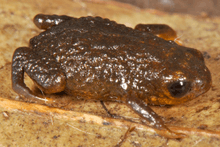Brachycephalus olivaceus
Brachycephalus olivaceus is a species of frog in the family Brachycephalidae. It is very tiny and was one of seven new species described by LF Ribeiro and a team of scientists from the Mater Natura - Instituto de Estudos Ambientais in Brazil. Like all species in its genus, it is found in a very small strip of Atlantic Forest in the southeastern coast of the country, and has a vibrant colour pattern.[1] The speciation seen in this genus is thought to be a byproduct of the rift between the valley versus mountain terrain and its particular microclimates, to which they are adapted. It might be in population decline due to habitat loss.[2] Its name derives from the Latin olivaceus, "olive-colored", in reference to its coloration.
| Brachycephalus olivaceus | |
|---|---|
 | |
| Scientific classification | |
| Kingdom: | Animalia |
| Phylum: | Chordata |
| Class: | Amphibia |
| Order: | Anura |
| Family: | Brachycephalidae |
| Genus: | Brachycephalus |
| Species: | B. olivaceus |
| Binomial name | |
| Brachycephalus olivaceus Ribeiro et al., 2015 | |
Description
It is distinguished from other cogenerate species by having a robust body, bufoniform, with an adult length between 9.4 to 12.9 millimetres (0.37 to 0.51 in); a rough dorsum, and its general coloration being predominantly dark-green to brown. The skin on its dorsum shows no dermal co-ossification. Its rugose body is similar to that of B. mariaeterezae (as opposed to the smooth dorsum of other species such as B. izecksohni or B. pernix. Its predominantly dark-green dorsum is distinct from all other Brachycephalus species. The species does not present dermal co-ossification characteristic of species within the phippium group, while its bufoniform shape and larger body size means it is rather larger than those in the didactylus group, averaging a length of between 8 to 10 millimetres (0.31 to 0.39 in) and in turn having leptodactyliform body shape.[1]
Distribution
Brachycephalus olivaceus is known only from two localities, which are the base of the Serra Queimada and Castelo dos Bugres, a notable rock formation in the northeastern State of Santa Catarina.[1]
References
- Ribeiro, Luiz F.; Bornschein, Marcos R.; Belmonte-Lopes, Ricardo; Firkowski, Carina R.; Morato, Sergio A.A.; Pie, Marcio R. (2015). "Seven new microendemic species ofBrachycephalus(Anura: Brachycephalidae) from southern Brazil". PeerJ. 3: e1011. doi:10.7717/peerj.1011. ISSN 2167-8359. PMC 4458131. PMID 26056613.
- Webb, Jonathan. "Seven tiny frog species found on seven mountains". BBCNews. BBCNews. Retrieved 4 June 2015.
Further reading
- Clemente-Carvalho, Rute BG; et al. (2011). "Molecular phylogenetic relationships and phenotypic diversity in miniaturized toadlets, genus Brachycephalus (Amphibia: Anura: Brachycephalidae)". Molecular Phylogenetics and Evolution. 61 (1): 79–89. doi:10.1016/j.ympev.2011.05.017. PMID 21693192.
- Da Silva, Helio Ricardo; Campos, Leandro Ambrósio; Sebben, Antonio (2007). "The auditory region of Brachycephalus and its bearing on the monophyly of the genus (Anura: Brachycephalidae)". Zootaxa. 1422: 59–68. doi:10.11646/zootaxa.1422.1.4.